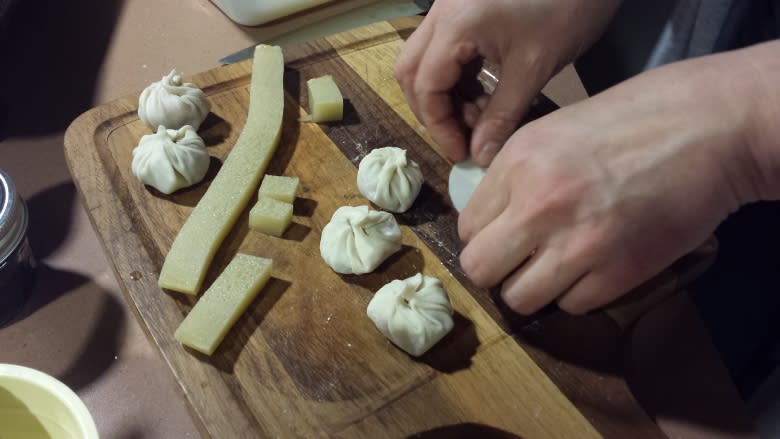Julie Van Rosendaal: Chinese New Year treats you can make at home

Festivities to mark Chinese New Year are already underway, with the celebration officially being marked on Thursday.
The Calgary Eyeopener's food guide Julie Van Rosendaal recently sampled some of the country's best Asian cuisine while on a trip to Richmond, B.C. Inspired by that culinary adventure, she joined host David Gray with her own Chinese New Year creations.
David Gray (DG): What were you doing in Richmond?
Julie van Rosendaal (JVR): I was eating. It's a great eating destination.
A lot of people say it's the place to go to for Asian food in North America [because of] the high Asian population [and] the availability of ingredients. There are over 400 Asian restaurants there.
Alexander Street has 200 restaurants in three blocks — everything from Cantonese to Shanghainese to Hunan. You see people hand-pulling noodles in malls there, you just don't see that here.
DG: A lot of Chinese New Year food has particular meaning, doesn't it?
JVR: It's true. In fact a lot of the food isn't that much different from the food that's served year round.
But there's more meaning to each thing you eat. So noodles for long life, oranges symbolize good luck, dumplings resemble little pockets, so they're supposed to bring wealth.
The visual cues are important. If it's long it symbolizes long life. Fish and chicken are often served whole symbolizing good beginnings and good endings.
Things like serving whole fish, you don't want to flip it when you're serving it because it symbolizes a fishing boat — you don't want to flip the boat. So they pull the whole spine out at once while they serve it.
The fish itself brings surplus and good fortune.
DG: One of the reasons I go out for Chinese food is that I'm convinced that I can't make it at home. But you are here to prove that incorrect.
JVR: Well I don't want to say it's easy, because the Chinese masters (not chefs, they call them masters) train for years and years, and the range of skills is just astounding.
All the different cooking techniques from deep frying, stir frying, steaming, braising — it's amazing the level of skill that goes into this cooking.
So I made some xiao long bao, which are soup dumplings that are popular in Shanghai, and they're very popular on dim sum menus and some steamed pork buns.
Xiao long bao
Stock:
- Bones of one roasted chicken
- Small carrot, cut into chunks
- A few slices of ham or Asian-style cured sausage
- A few sprigs of cilantro or parsley
- 1 green onion
- Big pinch salt
- 1 Tbsp. plain gelatin
Dumplings:
- 1 lb. ground pork
- 1/4 cup chopped cilantro (stems too)
- 2 green onions, finely chopped
- 2-3 Tbsp. soy sauce
- 2 tsp. grated fresh ginger
- 1-2 garlic cloves, finely crushed
- 2 tsp. brown sugar
- a squirt of Sriracha (to taste)
- 1 pkg. dumpling wrappers
Dipping Sauce:
- thinly-sliced fresh ginger
- dark soy sauce
- rice vinegar
- pinch dried red chili flakes (optional)
To make the stock, combine everything but the gelatin in a medium pot, cover with water and bring to a simmer. Cook over low heat, without bringing it to a rolling boil, for 30-45 minutes, or until you have a rich-tasting stock. Strain and pour back into the pot. Sprinkle the gelatin overtop (you should have about two cups of stock (reduce the gelatin if you have less) and let sit a few minutes to soften. Bring to a simmer, stirring to dissolve the gelatin completely. Pour into a loaf pan or other dish and refrigerate until firm.
- Julie Van Rosendaal explains the trick to putting soup inside a dumpling in the audio above.
To make the dumpling filling, combine the ground pork, cilantro, green onions, soy sauce, ginger, garlic, brown sugar and Sriracha, mixing gently with your hands to combine.
When you're ready to assemble the dumplings, put some water in a small dish and find a clean work surface, like a chopping board. Cut the gelled stock into strips, then into pieces about 1/3-inch square. (If you like, stir the pieces of gelled stock gently into the pork mixture.)
Place a few dumpling wrappers at a time on the board, and brush around the edge with water using a pastry brush or your finger. Place a small spoonful of the pork mixture in the middle of each wrapper, along with a square or two of gelled stock. Gather the dumpling up into the palm of your hand and pleat it all around the edges using your thumb, twisting it in a small topknot at the top to close. If it doesn't stick (most dumpling wrappers are coated with a layer of cornstarch), add another drop of water.
As you fill them, put them on a parchment-lined sheet and cover with a light towel. Steam over simmering water in a bamboo steamer basket (or in a rice cooker or other steamer), on a layer of parchment, cheesecloth or cabbage leaves, for 12-15 minutes, or until cooked through. For the dipping sauce, mix the ginger with about two parts soy sauce to one part vinegar, or to taste.
To eat, pick up the soup dumpling by its topknot using chopsticks, and transfer to a Chinese soup spoon. Either poke a hole in the side with your chopstick and let the soup run out into the spoon, or lift it up, bite off one side and sip out the soup, then eat the dumpling.
Makes two to three dozen soup dumplings.


